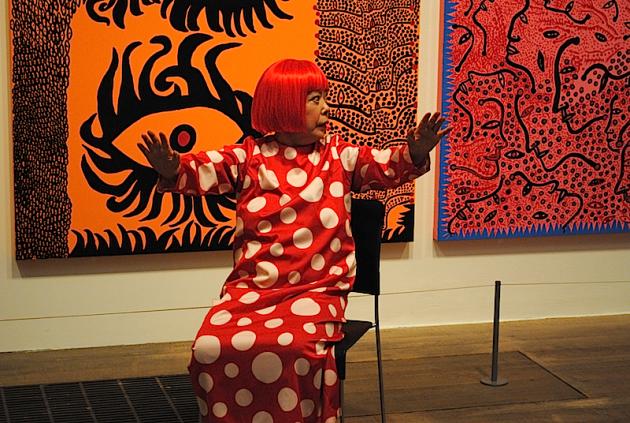Yayoi Kusama does not know where she stands in the art world. After having recently finished a major retrospective at the Tate Modern the artist still finds it difficult to believe that she has successfully carved a place for herself after years of struggling.
Tomorrow she is going to be teaming up with Marc Jacobs and the Louis Vuitton team to launch signature products that are sure to delight both the following Kusama unknowingly has created as well as the legions of Vuitton enthusiasts. Marc Jacobs is no stranger to the combination of fine art and fashion, having worked with the likes of Richard Prince and Takashi Murakami in the past, yet this project has been long awaiting Kusama who has been largely unrecognized until recently for the breadth of work she has created.
Kusama has not lead an easy life. She was born into a family in 1929 that was largely on the brink of falling apart. It was through the trials and tribulations, polka-dotted with affairs and constant neglect, that Kusama was able to find her artistic refuge and flourish. Her family was very traditional and strained to see the importance of having a daughter who was more interested in creating art than quietly collecting it. Every move that her parents made in preventing Kusama from creating work spawned greater creation and has since largely influenced her growing collection. Every piece and every spot has a narrative and speaks volumes of the struggles and jubilation that Kusama has faced over the years.
Not only had the pressure and negativity from her family formed a basis for her pieces she also had to come to terms with internal pressures brought on by her own psyche. Kusama travelled from Japan to New York and pursued a twenty year affair with the city that brought about some of her most exceptional work, also providing the artist the chance to engage with some of the most prominent artists to shape the scene in the early 1960s. Andy Warhol formed a relationship with the artist replicating her work with screen-printed cow faces, yet never fully giving her the credit for inspiring his own creations. She also befriended the sculptor Donald Judd and had a chance to meet her mentor Georgia O’Keeffe who championed the eccentric and charismatic artist’s move to the States while still in Japan. Upon returning to Japan Kusama suffered from a serious mental breakdown and decided to admit herself to a psychiatric hospital which she still lives in today. Other than working in her studio the artist spends a great deal of her time within the confines of the hospital claiming to find it very comfortable. Kusama also has mentioned in numerous interviews that a majority of her work comes from inexhaustible panic attacks with often provoke sensations of terror and abstract forms which appear in a great deal of her work.
This partnership with Louis Vuitton proves yet again that Kusama now in her early 80’s has indeed made it in the art world. The line of products that will be on sale later this month includes sunglasses, scarves, bikinis, towels, as well as clothes. It’s an enormous undertaking for anyone at any age let alone an 80 year old person who is now suffering from such pains as to prevent her from walking around with ease. With that in mind the artist is also going to be designing window displays for the Bond Street shop as well as a pop-up store in Selfridges on Oxford Street. Tomorrow the artist’s work will grasp the city of London with force. The artist has suggested throughout her career that she has always wanted to create pieces that make a statement. The statement for this partnership with Vuitton is one of “love forever” a mantra that Kusama continues to promote passionately even in her later years. She is no stranger to tragedy having lived in Japan during nuclear catastrophe and total destruction, and having experienced tragedy on a personal level with her family and own mental stability. Through all of that, she has become a champion of modesty and determination, a promoter of love, and a very prolific artist.
Words by: Portia Pettersen/Photo: Paul Carter Robinson © Artlyst 2012

